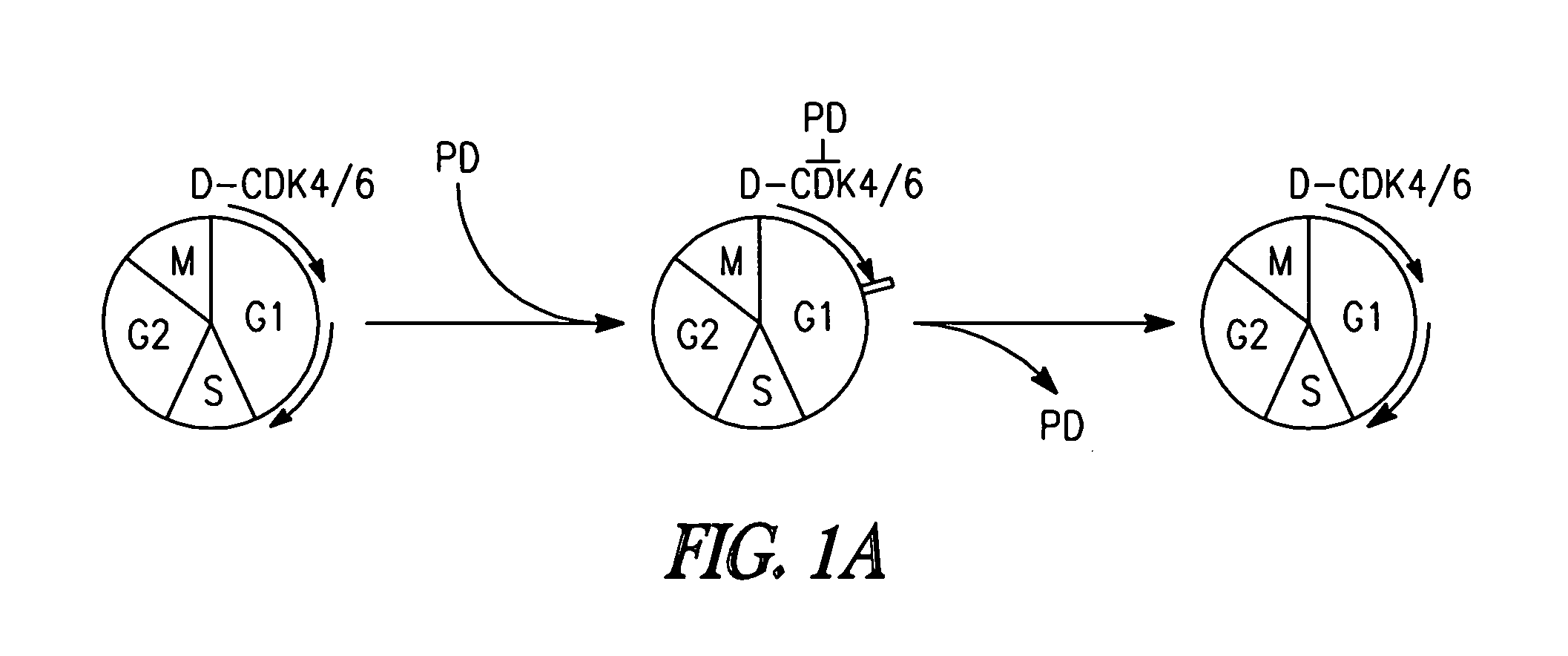Targeting cdk4 and cdk6 in cancer therapy
a cancer therapy and cdk6 technology, applied in the direction of tumor/cancer cells, drug compositions, instruments, etc., can solve the problems of insufficient control of the rapid expansion of cancer cells, no anti-cancer compounds that also selectively inhibit the cell cycle, and devastating cancers such as multiple myeloma are generally fatal, so as to reduce the susceptibility to chemotherapeutic agents, reduce the effect of cell growth and effective treatment of cancer
- Summary
- Abstract
- Description
- Claims
- Application Information
AI Technical Summary
Benefits of technology
Problems solved by technology
Method used
Image
Examples
example 1
Experimental Procedures
[0201]This Example describes some of the materials and methods used in developing the invention.
Isolation of Primary Bone Marrow Myeloma Cells and Cell Culture
[0202]Bone marrow specimens were obtained from multiple myeloma patients at the New York-Presbyterian Hospital under informed consent as part of an Institutional Review Board approved study. Primary CD138+ human BM myeloma (BMM) cells were isolated as previously described (Baughn et al., 2006) from the patients described in Table 1.
TABLE 1Clinical information of myeloma cases in this study.IgPriorMM #AgeDxStageIsotypeTx159MMIIIGκY243MMII′κY**346MGUS0GκN436MMIIIGκY*557MMIII′κY*644MMIIIGκY755MMIIIGκN863MMIII′κY960MMIIIGκY*1055MMIIIGκY1372MMIIIAκY1482MMIIIGλN1544MMII′λN1668MMIIGλY
BMM cells were co-cultured, at a 2:1 ratio with mitomycin C-arrested HS-5 stromal cells (ATCC, Manassas, Va.). For analysis, BMM cells were removed from stromal cells by gentle pipetting. The purity of the BMM cells was determined ...
example 2
Cell Cycle Inhibition Facilitates Cancer Cell Death
[0214]This Example illustrates two novel strategies to arrest the cell cycle and prime myeloma cells for cytotoxic killing.
Inhibition of CDK4 and CDK6 Primes Myeloma Cells for Cytotoxic Killing by Inducing G1 Arrest or Synchronous S Phase Entry
[0215]Inhibition of CDK4 and CDK6 by PD 0332991 leads to exclusive G1 arrest unaccompanied by apoptosis in primary CD138+ human BM myeloma (BMM) cells and human myeloma cell lines (HMCLs) (Baughn et al., 2006). However, the inventors hypothesized that sustained G1 arrest may perturb cell cycle-coupled cellular function, thereby sensitizing cycling myeloma cells to cytotoxic killing. PD 0332991 acts reversibly. Therefore, the inventors further hypothesized that release of the G1 block may lead to a synchronous G1-S transition and also heighten the sensitivity to cytotoxic agents.
[0216]To address these possibilities, a complete G1 arrest was induced with PD 0332991 (0.25 μM) in HMCLs, including ...
example 3
Inhibition of CDK4 / 6 by PD 0332991 Results in Abrogation of Osteoclast Formation
[0243]This Example describes preliminary results on tests performed to ascertain whether PD 0332991, alone and in combination with bortezomib, may inhibit osteoclastogenesis.
[0244]Non-adherent mononuclear bone marrow cells from multiple myeloma patients were cultured in the presence of macrophage colony stimulating factor (M-CSF) and Receptor Activator for Nuclear Factor κB lingand (RANKL) for three weeks.
[0245]Treatment of human osteoclast cultures with PD 0332991 for 3 weeks decreased osteoclast formation in a dose-dependent manner with an IC50 of 50 nM. The combination of PD 0332991 and bortezomib led to synergistic inhibition of osteoclast formation, and completely abrogated osteoclastogenesis using only low doses of PD 0332991 (25 nM) and bortezomib (2 nM). A time course study of PD 0332991 treatment indicated that a first week, but not second or the third week, was sufficient to inhibit osteoclast ...
PUM
| Property | Measurement | Unit |
|---|---|---|
| Time | aaaaa | aaaaa |
| Time | aaaaa | aaaaa |
| Time | aaaaa | aaaaa |
Abstract
Description
Claims
Application Information
 Login to View More
Login to View More - R&D
- Intellectual Property
- Life Sciences
- Materials
- Tech Scout
- Unparalleled Data Quality
- Higher Quality Content
- 60% Fewer Hallucinations
Browse by: Latest US Patents, China's latest patents, Technical Efficacy Thesaurus, Application Domain, Technology Topic, Popular Technical Reports.
© 2025 PatSnap. All rights reserved.Legal|Privacy policy|Modern Slavery Act Transparency Statement|Sitemap|About US| Contact US: help@patsnap.com



